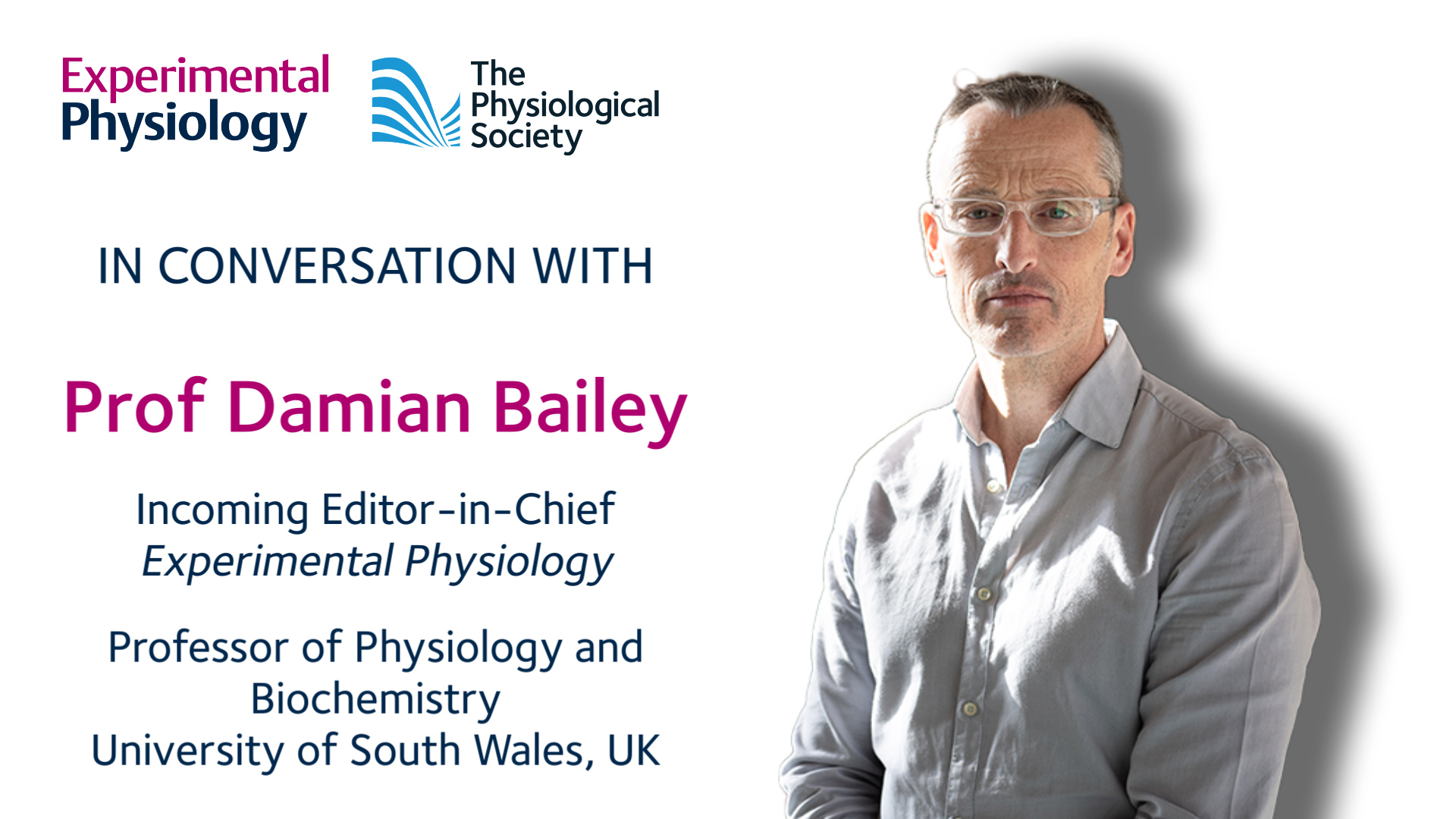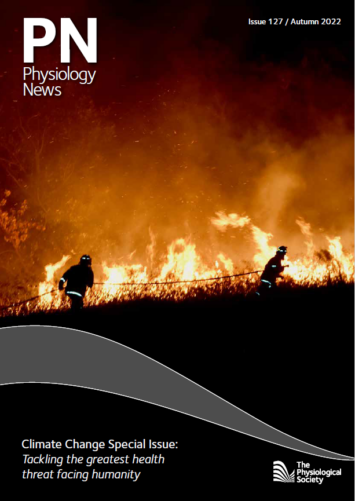
Physiology News Magazine
Looking forward to promoting the “power of physiology”
News and Views
Looking forward to promoting the “power of physiology”
News and Views

https://doi.org/10.36866/pn.127.11
Professor Damian Bailey
Editor-in-Chief, Experimental Physiology
It is both an honour and privilege to introduce myself as the incoming Editor-in-Chief (14th in history) of Experimental Physiology (EP), one of the prestigious “flagship” journals under the auspices of The Physiological Society and the community it serves. In my predecessor Professor Mike Tipton’s own words, he will shortly “stagger down the back straight and pass the baton on” to me, on 1 October 2022 (Experimental Physiology, 2022). On behalf of EP’s Editorial Board, its authors, reviewers, readers and publication staff, I would like to formally thank Professor Tipton for his tireless efforts and contributions that were an inspiration to us all. And for the record, there’s been no staggering, I can assure you. That he managed to attract 32 papers alone as part of the Extreme environmental physiology: life at the limits meeting organised by The Physiological Society in September 2019, stands as a clear testament to his influence and leadership, his championing of wholebody integrative human physiology and perhaps his most endearing quality of all, a genuine commitment to inspire our next generation physiologists. His tenure has seen EP’s research article submissions jump from 292 in 2016 to 484 in 2021, with accepted articles increasing from 95 to 128. I’d also like to thank The Physiological Society for the trust they have placed in my ability to lead EP over the next 3 years. I am excited about its future and fully committed to building on its impressive trajectory.
I’m especially excited given physiology’s optimistic future, despite the usual rumblings that it is a discipline relegated to the past, slowly dying at the hands of molecular biology and high-throughput DNA sequencing (Wagner and Paterson, 2011; Lemoine and Pradeu, 2018). Physiological research provides the essential integrative links between genes and clinical care and will continue to transform our ability to detect, prevent and treat human disease. It is only strengthened by exchanges with other fields, including the various -omics disciplines from which it can take translational inspiration (Lenfant, 2003). However, beyond the conceptual, we face practical challenges given that its wide remit has led to a perceptual blurring of the lines regarding which subdisciplines truly belong to physiology, reducing its visibility among educational institutions, policymakers and the public (Vaughan-Jones, 2016). Let’s work together through EP to highlight the discipline’s translational benefits so that physiology can be better supported and understood. This is best achieved through real-life examples (data) rather than simple table thumping. The translational gains in terms of understanding the pathophysiology and treatment of COVID-19 patients over the past three years stands recent testament to the “power” of integrated systems physiology. This was highlighted by Sir Patrick Vallance in his address to The Physiological Society (The Society, 2020), and EP’s very own Covid-19 special issue (Tipton et al., 2022).
Having had the privilege of serving as a Senior Editor to EP for the past four years, I am patently aware of the responsibilities that the Editor-in-Chief role entails. I approach this with humble respect and an equal measure of excitement and trepidation. I am also familiar with EP’s colourful history, surviving a stormy birth some 114 years ago when it started out against all odds as the Quarterly Journal of Experimental Physiology under the leadership of Sir Edward Sharpey-Schafer (Editor-in-Chief for no less than 27 years) with the vociferous backing of Sir Charles Sherrington, among others of the physiology elite (Whitteridge, 1983). The journal has weathered many storms, financial, political and the inevitable academic – and has continued to flourish. Yet despite its secure footing, EP now faces one of its biggest challenges as its transition to Open Access looms large on the horizon (The Society, 2019; Wiley, 2014). Like it or not, this change in publishing model is inevitable for the majority of publishers and journals to ensure compliance with funder mandates, and will fundamentally reshape how research is conducted, disseminated, communicated and assessed. We need to be ready for it.
And so to a brief note of my vision and aims – I shall purposely keep it high-level since I plan to solicit views from the Editorial Board and wider community as I take up my new role looking to further build said community, develop our brand, raise standards of scientific integrity, and shape physiology itself, in line with The Physiological Society’s current and upcoming strategy. My vision for EP is for it to be recognised as the world’s leading journal that publishes groundbreaking research in integrated translational physiology that challenges the boundaries of basic, applied and clinical research across the spectrum of health and disease. I want EP to address the big societal questions that really matter, with a focus on translational impact, not Impact Factor. I hope the research we publish will inform, if not indeed transform, change that can be measured and weighed. My primary aim will be to extend EP’s current reach and increase quality submissions as we transition to Open Access in January 2023, tapping into our collective networks of prestigious specialists working in allied disciplines while expanding clinical-scientist representation on our Editorial Board. We need to cast our creative net ever wider to help expand current communities while introducing new ones, broadening EP’s remit to include clinical (e.g. surgical, public health, big data epidemiological) and applied (e.g. exercise and elite sports, space biomedicine including industrial links with science technologists, environmental, comparative) physiology, to forge new partnerships with groups in Northern Europe (in particular Sweden, Denmark, Finland and Norway), South America, the Middle East and Asia. It is also important that we reflect and consolidate on those strategic initiatives that have proven successful (exercise and extreme physiology highlighted prior). We do not require revolutionary change; to the contrary, we require evolutionary tweaks. To paraphrase Professor Tipton, we need to keep the Daimler on the road and upgrade its sat-nav!
A brief albeit important final point. As a team, we cannot succeed without the understanding and support of some of the world’s best researchers on our Editorial Board, including our referees who work at the coalface, making an indispensable contribution reviewing submissions. They are our secret sauce, the DNA of the journal’s success, who give up their time selflessly for the love of the discipline and the journal! We encourage you to join us in this enterprise, fuel the fire by submitting manuscripts and contributing to reviews. We will also be welcoming applications to join our Editorial Board in due course as we look to expand and diversify. We also welcome comments and suggestions that could improve the quality and visibility of the journal, your journal.
Our special issue on heat stroke is soon to be published and is packed with fascinating insights and fundamental findings – keep a look out for further announcements.

References
Experimental Physiology (2022). Welcome to the Experimental Physiology newsletter. Available online at https://mailchi.mp/3eea472f55c8/welcometo-the-experimental-physiology-newsletter-1062937?e=1895836e8b
Lemoine M, Pradeu T (2018). Dissecting the meanings of “physiology” to assess the vitality of the discipline. Physiology (Bethesda) 33, 236-245.
Lenfant C (2003). Shattuck lecture–clinical research to clinical practice–lost in translation? New England Journal of Medicine 349, 868-874.
Tipton M et al. (2022). Covid-19 special issue. Experimental Physiology 107(7), 651-786
The Society (2019). Open Access (Online). Available at https://www.physoc.org/policy/open-access/
The Society (2020). Patrick Vallance (Online). Available at: https://www.physoc.org/honorary_member/patrickvallance/
Vaughan-Jones R (2016). Health of Physiology. ed. Society TP, pp. 1-22, Hodgkin Huxley House, London.
Wagner PD & PD, Paterson (2011). Physiology: found in translation. Journal of Physiology 589, 3899-3900.
Whitteridge D (1983). The origin of the Quarterly Journal of Experimental Physiology. Quarterly Journal of Experimental Physiology 68, 521-523.
Wiley (2014). Understanding Open Access (Online). https://www.youtube.com/watch?v=o2HMouOV-Lg
